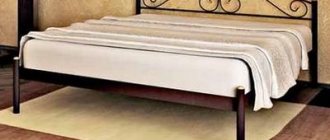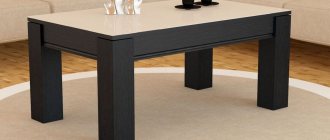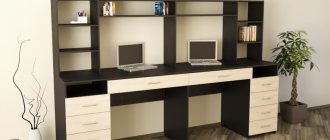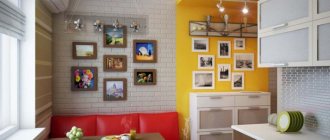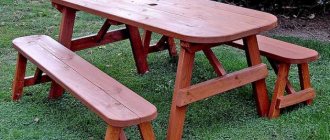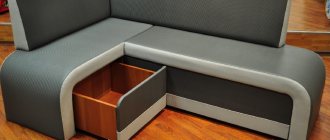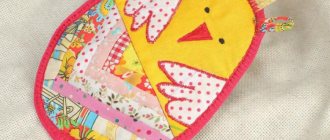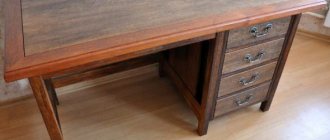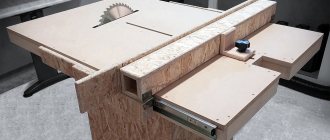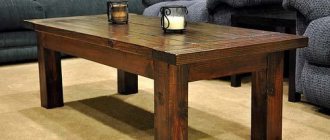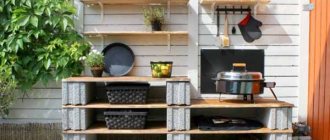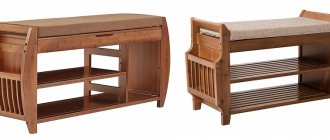A book table is a very popular and versatile type of furniture. When folded, it takes up little space, but if necessary, turns into a large table.
Stores sell book-tables for every taste, but they also cost a lot. But such a necessary and practical thing can be made independently.
How to make a book-table with your own hands and what is needed for this, read our article.
Types of book tables
There are many types of book tables, and each has its own pros and cons. Therefore, you need to decide which one is right for you. Let's consider several options:
- Book table with shelves You may remember such tables from the times of the USSR, but similar models are still produced today. The table consists of one narrow tabletop-frame, which is framed on both sides by large ones; they fold out. When assembled, they resemble a bedside table. Only one half can be opened.
- Table-book with chairs The interior space of this model of table-book is not occupied by drawers or shelves; several folding chairs can be compactly placed there. Very convenient for a small apartment: a small cabinet can accommodate an entire dining set.
- Book-table with barAn interesting option for the kitchen or living room is a mini-bar on the table. If necessary, drinks leave the cabinet in a roll-out basket.
- Coffee table-book has standard functions of a table-book. They just make it smaller to match the characteristics of a coffee table. A very comfortable and stylish thing, perfect for any interior.
Coffee table-transformer mini-book. A compact and practical book-table will fit perfectly into the modern design of a kitchen or living room. The use of different materials and a variety of colors allow you to choose a table to suit any interior, be it a red kitchen or a kitchen in brown and beige tones.
Please note: book tables with drawers and shelves filled with things are quite heavy, and it takes two people to move them. A good solution is to put the table on wheels. It can be easily moved indoors.
Which countertop shape should you choose?
It is important at the stage of designing the table to decide on the shape of the tabletop that will suit the specific type of room. We will take a closer look at the most common options
Table 2. Shapes of table tops for an extendable table.
| Shape, illustration | Description |
Square | When assembled, such products can be miniature or large - this will depend on the size of the kitchen and dining room. The extendable table can accommodate 6 to 8 people. The only downside is that due to the presence of all four legs at the end, only one person can be seated, and this is not always convenient. |
Rectangular | A table of this type can be installed in both small and large rooms; it can accommodate up to 12 people. This type of countertop should be chosen by large families or those owners who often invite a large group to visit. |
Round | This is a rather unusual shape for an extendable table. This design is also suitable for rooms of various sizes - due to the lack of corners, the table will not take up too much free space, and thanks to this feature it can be moved around the room if necessary. In addition, such a model is ideal for an apartment where small children live, because the risk of injury by hitting a sharp corner is minimized. When assembled, the diameter of such a tabletop is about 90-110 centimeters. When unfolded, the structure becomes oval. |
Octagonal | This is an unusual version of an extendable table top. It is more difficult to make such a design, so it is better for novice craftsmen not to choose it. However, the finished table will be very functional. When assembled, it can accommodate six to eight people; when disassembled, it can accommodate twice as many. This is an excellent option for a large family, in which it is customary to have breakfast at different times, and have dinner all together, at a large table. |
Book table with cabinet
When folded, this table resembles a cabinet with drawers and shelves. It is usually chosen by housewives. It is very convenient to store various things in it.
In addition, the table is perfect for a woman who sews, as it can easily be turned into a workspace (read how to make a sewing table in this article).
The book-table supports can be wooden or chrome-plated. They do not differ in quality, both supports are stable. You can choose the option that best suits the interior.
Remaking a Soviet lacquered table – Fair of Masters
We received an old, varnished table from a customer. All dirty, covered in marks from hot dishes. In general, it looks sad, the owner wanted it in the trash.
When we took it for restoration, we realized that it was made of solid beech and veneered with walnut. We thought this was simply a priceless specimen, and after consulting with the customer, we decided not to repaint it, but to remove the old varnish and whiten it.
I'll show you a little bit of the process.
We didn’t have time to take a photo of the old table as assembled; it was taken from the customer in a disassembled, sad state. Below is a photo of the tabletop. It is obvious that they did not spare it; they put hot dishes on it, cut it with a knife and dirty it with anything.
So, we got to work. To begin with, the most difficult and time-consuming thing is to remove several layers of varnish. We filmed in two ways. The first is sanding with a sander. And the second method was to heat the surface with a construction hairdryer and pry off the varnish layer with a chisel. The varnish gave in perfectly and was removed in one layer, like leather))) Below is a photo with and without varnish. We discovered a stunningly beautiful walnut veneer.
The customer has a light interior, so the table was ordered in a light version. After consulting, we decided to cover it with white furniture varnish. In this way we both protect the surface (the varnish has a very high resistance to scratches, stains and water) and do not block the beautiful veneer pattern.
This is what ended up happening.
In my opinion, this is an amazing rescue of a valuable specimen))
All the best,
Family workshop, Andrey and Anna Panikhin
www.livemaster.ru
Materials and tools
To make such a model of a table-book, you need to cut the following blanks from laminated chipboard and fiberboard according to the specified dimensions: In addition, to make the table you will need:
You will also need the following tools:
- pencil, tape measure; Phillips screwdriver or screwdriver; hex wrench (4 mm); jigsaw; hammer.
Please note: Laminated particle boards are difficult to cut at home. You can draw up a cutting diagram and go to a workshop where specialists will cut out the table parts.
Complete restoration of original appearance
This method of “rehabilitating” a table made 30-40 years ago is more expensive than simply covering it with film. First, you will need to completely remove the paint layer and polish the wood thoroughly. Since you will need to put the appearance of the entire “object” in order, you need to expect that it will take quite a lot of not only time, but strength and patience.
After you have thoroughly polished the wood, you need to dust off the surface of the particle board and the legs of the structure. After the described procedures, you can stick on special structural paper. This must be done as carefully as possible so that the joints are not noticeable.
Stages of work
Step 1. Attach the ends to the sides of the table (3, 4). Do this with nails. Secure the roller guides to them with screws (3.5 x 16).
The sides of the table (3, 4) are connected by the bottom (8) and the drawer (7). Use dowels and a screw tie. Make holes in the sides and frame and insert eccentrics there.
Please note: the arrow on the eccentric must be directed towards the end of the part.
Step 2. Screw the eccentric rods into the holes on the table top (1). the card with screws (4 x 16) . Lower the tabletop onto the sides. This must be done so that the eccentric rods fit into the holes in the ends of the sidewalls and the frame. On the sidewalls and frame, turn the eccentrics 180 degrees clockwise.
Step 3. Attach the ends to the retractable sides (5) using nails. Insert eccentrics into their holes. Do the same with the mounting strips (6).
Take the double-sided eccentrics and insert them into the ends of the mounting strips. You need to insert it with the long side. Turn the eccentrics 180 degrees clockwise.
Drill holes on the mounting strips and insert dowels there. The extendable table support must be attached to the mounting strip.
Turn the eccentric 180 degrees clockwise. Using screws (4 x 16), you need to attach the card loops (5) to the mounting strips (6). Screw the hinges (3) already attached to the mounting strips to the sides of the table (4).
Step 4. Insert the shelf supports into the holes of the additional tabletops. Screw the additional table tops to the card loops that are attached to the main table top. The eccentric and screw couplers must be closed with plugs. Take screws (4 x 16) and use them to secure the mating parts of the four-hinged hinges on the side of the table (3).
Attach four-hinged hinges to the door (10). Do this with the same screws. Screw the handle with M4 x 20 screws and hang the doors.
Secure the hinges with fastening screws to the mating parts. Insert shelf holders into the holes on the sides (3, 4). Place the shelf (9) on them.
Step 5. It is necessary to assemble the boxes. Using a screw tie, connect the back wall of the box (13) with the side walls (14).
You need to screw the eccentric rods into the holes on the façade and insert the dowels. Connect the façade with the side walls. This must be done so that the eccentric rods and dowels fit into the holes on the side walls.
Insert the bottom of the drawer (14) into the groove. Secure it with nails. the mating to the sides of the drawer (6) . This needs to be done close to the facade, using screws (3.5 x 16). Attach the handles using M4 x 20 screws .
Insert the drawers into the cabinet. To do this, you need to tilt the drawer and place it so that the rollers of the drawer guides rest on the guides on the sides of the cabinet. Lower the drawer and push it into the cabinet.
Important: the box should move smoothly along the guides, without squeaking or rubbing, and slide out without effort.
How to make a table-book with your own hands, drawings and diagrams can be seen in this video:
- Author: Svetlana K. Print
PhotoLack of space often occurs among apartment owners, especially when it comes to furniture. A DIY book table, which is not too difficult to make, can help solve this problem. This table takes up very little space when folded, so it is the best option for small apartments or where several tables are needed at once.
Thanks to its simple and compact design, the book table is perfect for small spaces, such as the kitchen, since it can be folded if necessary.
The book table itself is not inferior to a regular table if it is made with high quality, but at the same time it also saves living space. In order to make such a book table with your own hands, you will need the following materials and tools:
- jigsaw; drill; iron; office cutter; square; pencil, marker; level; tape measure; screwdriver; chipboard sheet; furniture edge; self-tapping screws, screws; furniture hinges; corners.
A standard sheet of chipboard, when cut correctly, produces 2 tables, so there is no need to worry that there may not be enough material.
Calculation example
Let's look at the details of the cabinet with dimensions of 720 mm high, 500 mm wide and 450 mm deep. Furniture consists of parts, the name of which indicates their location in the structure - bottom, sides, slats, lid, shelf, back wall and facade.
Bottom
Cabinet depth 450 mm. The depth of the bottom is separated from the total depth by the facade, the thickness of which is 20 mm. This means the depth of the bottom is 450 - 20 = 430. The width of the bottom is 500 mm, this is clearly visible in the diagram - no parts separate the bottom width from the total width.
500*430 – 1 Bottom
Planks
The strips are located between the sidewalls, and the total width of the body is 500 mm and the thickness of the plate is 16 mm. From the width of the cabinet we subtract two sidewalls 500 mm -32 mm (16+16) = 468 mm. Let's set the width for the slats to an arbitrary one - the smallest is 60 mm. As a result:
468*60-2 Planks
Sidewalls
Total height 720 mm. The sides are located in height between two parts, namely the bottom and the lid. Accordingly, 720 mm – 32 mm (16+16) = 688 mm. The façade is separated from the total depth by 450 mm -20 mm (façade) = 430 mm. We get:
688*430-2 Sidewalls
Lid
The size of the lid is equal in width and depth to the dimensions of the cabinet. The lid overhangs the facade, so the depth is 450 mm. In order for the lid to well cover the ends (cut of the plate) of the sidewalls, I add 1 mm to the width of the lid. As a result:
501*450 -1 Cover
Removable shelf
The shelf will be removable for ease of use. It is located between two sidewalls, which means its width is 500 mm -32 mm = 468 mm. Because The shelf is removable; we make a gap of 1 mm on the sides. The depth of the shelf is 20 mm. As a result:
466*410-1 Removable shelf.
Rear wall and façade
The back wall and facade are separated from the total height of the cabinet only by the lid, so 720 mm – 16 mm = 704 mm. A technological gap of 3-4 mm in height and width is required. Accordingly, the size of the facade is:
700*497-1 facade=rear wall fiberboard or HDF.
Total:
- 500*430-1 bottom
- 468*60-2 strips
- 688*430-2 sidewalls
- 501*450-1 cover
- 466*410-1 removable shelf
- 700*496-1 facade
- 700*496-1 rear wall
Example of kitchen wall cabinet detailing
It is important for me to see the location of the part in the design and then the process goes smoothly. Moreover, you can always check the dimensions of the parts when the diagram is in front of your eyes. The picture shows a diagram of the assembly of a standard kitchen cabinet
The picture shows a diagram of the assembly of a standard kitchen cabinet.
- 720*280-2 sidewalls
- 268*280-2 horizons
- 266*260-1 removable shelf
- 716*296-1 facade
- 716*296-1 DVPO
Example of cabinet calculation
Let's complicate the task a little. Let's calculate a cabinet wardrobe with hinged doors, where the internal size will be specified. I recommend that you calculate it yourself and then check it with my details.
Click here to see cabinet detailing
- 2168*500-2 sidewalls
- 900*500-1 bottom
- 902*520-1 roof
- 1680*495-1 partition
- 868*495-1 horizon
- 318*495-5 shelves
- 2180*446-2 facades
- 2196*896-1 rear wall
Even if they made mistakes, it was simply due to carelessness. I admit that technologists make most mistakes this way. Because it is difficult to make a mathematical mistake in such simple actions.
Conclusion
In conclusion, I would like to draw your attention to the assembly diagram. Draw by hand, drawing every facet of the part, and then you can easily cope with the task. This is how I learned to calculate furniture and still do it this way.
This is how I learned to calculate furniture and still do.
If you need detailing of cabinet or built-in furniture, please contact us. We will definitely discuss the terms of cooperation and come to a common opinion. For a moderate percentage of my work, I will prepare a detailed project for you on time.
What would you like to add to this article?
I will be very interested to hear your stories!
With good thoughts about you, always in sawdust
Rekun Dmitry.
How to make a table book: the preparatory process
Folding table diagram.
The purchased sheet of chipboard must be cut to size; you can entrust this to the craftsmen in the workshop, but if you have an electric jigsaw, cutting it yourself will not be difficult. It is preferable to take laminated and moisture-resistant chipboard for the table. When marking and sawing, it is enough to adhere to some rules, knowledge of which will greatly facilitate the work.
All lines drawn on the sheet must be cut through before final sawing. When working with a jigsaw to make a table book with your own hands, you should not guide the file clearly along the contour itself, but step back 2-3 mm from it outward. This will allow the resulting chips to appear outside the part.
Chips will inevitably appear when cutting yourself, so it is better to insure your work.
After cutting, the end must be treated with sandpaper with a fine or medium structure.
To make a book table, you will need to saw the following parts: a narrow central part of the table top, which acts as a binding, and two large covers for the table. Additionally, you will need racks for the central part or main supports and crossbars for the main part in the amount of 3 pieces.
You will need 4 pieces of stands for retractable legs. strips that will connect them to the sidewalls, also 4 pcs. To strengthen the design of the retractable legs, 2 more strips are used.
Selecting a model and drawing
A book-table is a transformable furniture in which the tabletop consists of three parts, where the center remains fixed, and the side “wings” can be folded and unfolded. When lifting the moving part, it is supported on retractable legs. There are various designs of this model:
- A table-book without a central part takes up less space and is as compact as possible when folded. It only has sides and supports. When made independently, they require less material.
- A table with a central but non-functional detail. In such models, the element located in the middle is not equipped with any shelves or partitions. This was done in order to save the maximum amount of space.
- Product with a cabinet in the central part. This model combines a table and storage space. Making a cabinet table with your own hands will require more materials and, accordingly, the skills of the craftsman.
- A transforming table is a model that, if necessary, becomes a niche for chairs, a minibar, dishes and other things.
Without central part
With cabinet
With central part
Transformer
It is really difficult to make a choice among such a variety of models. When figuring out how to make a table-book with your own hands, it would be useful to take into account the recommendations of experts:
It is best for carpentry specialists without experience, as well as for beginners, to give preference to the simplest variation of the book: without an internal niche for things. An experienced master can choose any model he likes. The side parts are usually rectangular in shape. If the cut is ordered in a workshop, then if desired, you can round them. A table of this model can be used as a dining table or coffee table. The assembly details and design will be identical, but the dimensions will differ.
Coffee tables of this type are very comfortable and compact. It is important to consider the types of table materials that will be used in construction. Laminated chipboard for such work is recognized as a classic; the raw material is suitable for all components. But there are other possible variations: cut the tabletop, side “wings”, stiffeners, drawers from chipboard, use timber for the legs
Or make the legs and stands for the side “wings” from steel pipes with wheels at the ends (this option is best suited for a coffee table). You can make the central part, legs, drawers from metal, and take impact-resistant glass for the tabletop.
But there are other possible variations: cut the tabletop, side “wings”, stiffening ribs, drawers from chipboard, use timber for the legs. Or make the legs and stands for the side “wings” from steel pipes with wheels at the ends (this option is best suited for a coffee table). You can make the central part, legs, drawers from metal, and take impact-resistant glass for the tabletop.
If you want to make a book-table with your own hands, drawings and diagrams will be a good help in the work process. You can do them yourself, if you have the necessary skills, but it is preferable to use ready-made options as a basis. This method has many advantages:
- significantly speeds up work on the product;
- no need to build a drawing from scratch;
- less risk of inaccuracy or error;
- if necessary, you can make the necessary changes;
- You can always make a calculation using your own sizes.
Once you are completely satisfied with the parameters of the future product, you can begin to display the design in detail in accordance with the dimensions in the quantity required for production. The detailing and cutting sheet are prepared based on the drawing. Afterwards the cutting is done directly.
How to make a table: assembly
Drawing of a table-book.
Before the book table is assembled, the ends of all previously cut parts are processed by applying a furniture edge. In order to achieve maximum accuracy when working, the parts are clamped in a vice, lined with felt so that they do not leave marks. The tape placed at the end must have an allowance of at least 2 cm for each treated area, this is due to its ability to shrink.
The edge tape is applied to the end of the workpiece with the adhesive part facing down. Then the tape is smoothed along its entire length with a hot iron for at least 15 minutes.
The iron should not be too hot; after processing, the edge is additionally smoothed with a dry cloth to improve adhesion. The excess is cut off with a sharp knife. Defects that appear along the edge can be eliminated using sandpaper.
To make a book table, its retractable legs are assembled using Euroscrews. For this purpose, a through hole is made on the front side of one of the parts.
The same hole is drilled on the second part, but of a smaller diameter. The parts need to be fixed using the confirmat and then the location of it must be closed with a plug. All areas where fastening is carried out using a Euroscrew should be treated in the same way.
The next step, in order to make a table, should be to attach furniture hinges to the legs, of which 2 pieces will be required for each leg. To assemble the central leg, the lower jumper is mounted in a horizontal position, the height from the floor is 10 cm, its location should form a right angle with the racks.
On both sides, 7 cm is removed from the edge of the rack to accommodate the central jumper. The next jumper is mounted vertically in relation to the bottom one, and the last rib is fixed in the center. It is located between the tabletop and the second lintel
The finished base for the table book is placed on top of the central part of the table top. From the edge of the table, the support posts should be at a distance of 3 cm on both sides.
The entire structure is connected by corners; 2 pieces are taken for each side. The central part of the table is connected to the lids using furniture butterfly hinges. Before making a table, it is turned over, in this position the lids and retractable support legs are screwed on.
Content:
- 1. An economical option for a book-table. Necessary tools. Detailing of a book-table. Required accessories. Assembling a book-table. 2. A more elegant do-it-yourself book-tableRequired tools and accessoriesDetailingAssembling a second book-table
Initially, our apartments were not conceived as housing, but rather as a refuge. Shelter from rain and cold - no more. From this point of view, everything is absolutely correct: it’s warmer in close quarters.
But you can no longer receive guests - a large table takes up the entire living space. Although the furniture stores present such simple solutions that you can’t help but think: Do-it-yourself book-table - is it really that difficult to make? Everything is quite simple, especially if your hands are tailored to the desired format and you want to save money.
Making a table-book is quite simple
Here it makes sense to consider the manufacture of two different versions of tables, united by one common goal - to open to their full width only at the right moment.
Making furniture yourself: advantages
Not every person can decide to independently manufacture various pieces of furniture, but such actions have several main advantages:
- Saving. This is a good opportunity to save your budget, because you don’t have to pay furniture makers for services.
- The most accurate measurements. You can not only pre-measure the place where the table will be installed, but also adjust some details while working.
- Creation of a unique design. Only on your own can you create an exclusive table that cannot be found on sale.
- Possibility to buy only good quality materials. Furniture shop craftsmen do not always act in good faith, and in order to earn more, they purchase low-quality materials and accessories. That is why it is recommended to do your own purchasing - you won’t fool yourself.
Making furniture with your own hands has a large number of obvious advantages.
Of course, in the absence of any skills in making furniture, making it yourself is a certain risk, because a beginner can simply ruin the materials due to inexperience. But, if you do everything slowly and thoughtfully, then even the first time you can get a very worthy result that you can be proud of.
Economical option for a book table
Such a table is cheaper to manufacture and more compact, but has a number of disadvantages. Which, however, is reconciled by the price.
Economical option for a book table
Dimensions when folded: 750x800x200 mm. When unfolded: 750x800x1600 mm.
In the picture it is shown with rounded corners, but this is additional expense for figured cutting and edging, so we will go quickly and cheaper, that is, without aesthetic delights.
What are the advantages of a homemade item?
In this article we study not only the theory of folding tables, but also learn how to make them with your own hands. Why not buy the product in a store? Of course, it is much simpler, but a homemade folding table has several advantages that a table from a store does not have. The advantages of a handmade product look like this.
An example of an original folding table
- Uniqueness and originality. All tables, handmade for ourselves, have no analogues in nature. In any case, they will be individual in all respects. Only factory models can be absolutely identical to each other.
- Reliability. Homemade tables are made conscientiously, “for yourself,” so they will definitely be durable and will not break very quickly. They will likely last for decades. The main thing is to choose good materials for manufacturing and reliable fittings.
- Cheapness. A high-quality, reliable folding table in a store is expensive (we’re not talking about cheap, fragile structures). Making a reliable product with your own hands will be much cheaper. You just have to spend time.
- Design. When creating a homemade table, you can use your imagination and come up with an original design that no other product will have. Even the shape of the tabletop or its decoration and coating can be anything you want.
Table transformation mechanisms
Folding kitchen table
Detailing of the book table
You must immediately and forever remember that sheets of laminated chipboard at home cannot be cut accurately and without chipping, so you will have to order the main cutting from a furniture company or a construction supermarket.
The details are given for a chipboard thickness of 16 mm and a melamine self-adhesive edge 0.5 mm thick:
- 733x200 – 2 pcs., table sides. 700x800 – 2 pcs., table “wings”. 200x800 – table top. 727x120 – 2 pcs., table drawers. 727x70 – 4 pcs., leg stands. 500x70 – 4 pcs., leg drawers.
The parts are edged as follows:
- The edge is placed on the end of the part with the adhesive side down and ironed with a hot (3/4 power) iron. Then, while the edge is still warm, you need to rub it over the top with a dry cloth several times, achieving uniform gluing. Remove the excess edge with a knife and clean the edges with sandpaper.
It should be noted that two and a half of these tables can be made from a standard (2440x1830x16) sheet of chipboard. So it makes sense to team up with a neighbor or accept an order for a second copy from a neighbor. This is worth considering before going to a specialized store to buy components.
Homemade table for the kitchen
To make a classic-type kitchen table, it is not necessary to have professional skills and many years of experience as a carpenter. However, carefully studying master classes on making wooden tables yourself at home and getting recommendations from the masters will not be a bad thing.
By calculation, you should determine the size of the tabletop and the location of its installation in the design position. The number of table support legs will also become clear. After creating a working sketch, you need to prepare all the necessary material and tools.
Boards for the tabletop are laid out on a carpentry workbench. The edges of the boards are coated with glue, tightened with a clamp and left to dry for three days. After drying, carefully trim the edges and sand the surface with a hand sander.
The drawers are attached with screws using a steel angle to the back of the tabletop. The last step in assembling a homemade kitchen table is attaching the support legs. The legs are attached to the drawers with screws. The assembled structure can be covered with stain and several layers of colorless varnish. The refectory table is ready to receive its first guests.
Required accessories
Confirmats 5x70 (if you don’t stop at making a table, buy a package). Self-tapping screws 4x16 (similar). Window hinges or otherwise “butterfly hinges” with a “wingspan” of 30-35 mm, 10 pcs. Plastic L-shaped linings for furniture legs or so-called “hooves”, 3 mm thick, 4 pcs.
Let's take a closer look at this point right away. On each side of the table, one of the “hooves” is attached from below to the movable stand of the leg, extending the delta to the floor, and the second is attached to the “wing” of the table from the inside, finally fixing the height and position of the leg when open. Fastening with self-tapping screws 4x16. Furniture corners 4 pcs., for attaching the tabletop to the sides.
Recommendations for girls
Almost all movements with the butterfly simulator are quite simple. However, 1-2 exercises are allocated for each muscle group, which is enough to work almost all the major muscles.
Keeping the load moderate, try to perform all movements in a high-repetition style - about 15 to 20 repetitions in each set. The number of approaches depends on your training experience. Beginners are recommended to limit themselves to 3-4 sets, with a higher level of physical fitness - up to 10 for each group.
However, always be guided by your feeling of fatigue. The best choice when working with a butterfly expander is fullbody training (pumping the whole body at one time) for 25-40 minutes. This regimen will not only tone your muscles, but will also increase endurance and stimulate fat burning.
Assembling a book table
Assembling the base of the table.
Here and below: Drilling for confirmations in a plane - an 8 mm drill, through. At the end - a 5 mm drill, hole depth at least 60 mm.
We draw a vertical line in the center of each sidewall - this is the axis of the drawer fasteners. The drawers, oriented perpendicular to the floor, are pulled together with the sides.
The upper drawer is flush with the top, the second drawer is 50 mm away from the floor. We screw the table top onto the corners. The canopies protruding from the sides must be identical.
We screw the vent hinges to the tabletop along the axes, as shown in the figure. Side hinges – with a distance from the edge of the table top of 120 mm.
Screw the window hinges to the tabletop
The legs are a copy of the table with the difference that the upper drawer is oriented parallel to the floor. We fasten the legs with loops to the table frames (according to the picture), distributing the difference in height equally - these gaps are selected with “hooves”, as indicated above.
Attaching the legs of a book table
We turn the base over with the tabletop down and attach the “wings” of the table to the hinges simply in place.
Such a folded table can even be placed outside the door, and the cost compared to store prices is an order of magnitude lower.
Tables made of PVC pipes
How to make a table from PVC pipes
PVC pipes, it turns out, are an excellent material for making furniture; they are not inferior in strength to metal pipes, and the design is much lighter. The author of this master class clearly showed what can be made from a hollow door and a set of PVC pipes. The step-by-step photographs show how to make a table from PVC pipes with your own hands, or rather assemble it; this word more fully reflects the essence of the process. In the gallery you will find assembly diagrams and photos of the necessary parts; if you need instructions and explanations, a link to the author’s website is under the gallery.
Photo source usamodelkina.ru/1704-krasivyy-i-nedorogoy-stol-iz-pvh.html
Table made of pallets and PVC pipes
Here's how to make a simple table using one pallet and PVC pipes.
- Step 1: Remove the tray, that is, simply disassemble and set aside those parts that will be needed for the countertop.
- Step 2: Making the countertop. It’s also not complicated, lay two boards parallel, secure six boards evenly on them with self-tapping screws (or nails), saw off the excess, sand and varnish (or paint).
- Step 3: Assemble the legs from PVC pipes. Prepare pipes and tees. The gallery contains photos with the indicated dimensions. Cut the pipe into pieces of the required size. Measure 5cm from the end of the wooden strip and glue the connectors to the table using superglue.
- Step 4: Assembling the structure. In this case, PVC pipes with a diameter of 10 cm and 6 T connectors were used. It is necessary to cut - 1x93 cm, 2x61 cm, 2x 51 cm, 2x 41cm, 2x5 cm.
See the photo for the connection order. Finally, paint the pipes black.
Photo source www.instructables.com/id/Table-Made-With-Pallet-and-PVC-Pipe
Children's table made of PVC pipes
Need a table for the kids? The author offers a simple version of a light and comfortable children's table made of PVC pipes, which you can assemble in one day, like a construction set. First, cut the pipes to the required length. Dry assemble the frame to check how everything fits. Then make a tabletop - a sheet of durable plywood will do. When all the parts are ready, you can glue the pipes. When dry, attach the tabletop as in the photo.
Photo source www.instructables.com/id/How-to-make-a-Lego-table-out-of-PVC-pipe
Simple coffee table made of plastic pipes
Photo source www.instructables.com/id/Super-Simple-DIY-Coffee-Table-Made-From-Waste-Pipe
Glass coffee table made from PVC pipes
The author of this masterpiece, Dan Fairs, shows how to make a stylish coffee table using PVC fittings and wooden dowels. What you will need: four wooden dowels, 2 PVC pipes, crosses, cement for plastic, green spray paint, dark varnish, brushes, rags, self-adhesive vinyl tape, a tape measure, a pencil and a round glass for the tabletop. The manufacturing procedure is shown in step-by-step photos, everything seems to be clear. If you need detailed instructions, the link is below the gallery.
Photo source www.hgtv.com/shows/danmade/how-tos/how-to-make-a-pipe-and-dowel-coffee-table
Beautiful coffee table made of pipes
This amazing design can be made from four plastic tubes and eight adapters. Beautiful. But it’s hard to say how durable it is; you just have to take the author’s word for it. You can’t make it without drawings, it’s hard to see in the picture, the first photo is the master’s sketches. In principle, how to do this is clear, but how to make it so that it is even is not very clear, at least according to the photographs. However, you can read detailed instructions on the website.
Photo source pvc-innovation.wonderhowto.com/how-to/make-4-element-table-with-pvc-pipe-0131924
Original table made of pipes
To assemble this table you will need a minimum of tools: tape measure, marker, pipe cutter, wood saw. In addition, you need to stock up on finishing materials - pipe paint and wood stain. The amount of materials will depend on the dimensions, if you want a wider table enlarge your rack with 1x6 or even 1x8 boards and change the length accordingly to the width of the connecting pipe to maintain a tight fit. For the touches you will also need screws; 4 boards, a box for an electrical outlet, the outlet itself, a cable, a drill and a screwdriver. The assembly procedure and dimensions for this table are indicated in the diagrams in the photo gallery, although in inches (1 inch - 2.54 cm).
Photo source www.instructables.com/id/PVC-End-Table
150 photos of examples of tables made of pipes
Detailing
Unfortunately, the edging on book tables does not look very good due to the joining in the most noticeable places. Therefore, we order sawing immediately with figure saws and factory pasting. In this case, for extra beauty, we recommend ordering 2 mm thick PVC edge gluing.
So:
- 900x400 – table top 900x700 – 2 pcs., table top wings 733x400 – 2 pcs., table sides 800x200 – 4 pcs., side drawer and box parts for storing stands.
What to feed exotic insects
The basis of butterfly nutrition in nature is nectar. It’s easy to make your own delicacy that will appeal to tropical residents. To do this, sugar or honey is dissolved in water (in a ratio of 1 to 10). It is recommended to feed unusual pets once or twice a day.
Pour the sugar solution little by little - there are often cases when, while eating, insects get their wings dirty due to carelessness and then have difficulty flying. The butterfly must be carefully placed on the edge of the saucer. If she refuses the treat, try using a toothpick to gently untwist the proboscis and guide it into the syrup. After finishing the meal, the butterfly will fly away.
In addition to sugar syrup, insects like to feast on rotten fruits - apples, bananas, melons and oranges are suitable.
Assembling the second book table
If you carefully read the first part, you will not have a question about how to make a book-table with your own hands, regardless of the modification. Refer to the attached picture and the drawings of the upper section.
There is, however, one important point.
When you begin to attach the bases for the metal legs to the tabletop, make sure that when closing (folding) the table they do not rest against the sides. In addition, the instructions for such legs show that after connecting the leg to the base, it must be secured with a fastening screw. In your case, this should not be done, because the legs should be freely removed and stored in the box.
Now a little about the difference between the two table models given. Without looking at the cost - constructively.
In the first case, the base of the table is narrow, and there is only one leg on each side, mobile and located at an angle. That is, the table turns out to be quite unstable, especially during a vigorous celebration of something. Although it is quite suitable for peaceful gatherings.
But, you shouldn’t find fault with the tables if you haven’t left the apartment. Enjoy your holidays at your new table!
The book table is made by hand using chipboard. The material is cut in specialized workshops. To make such furniture yourself, you will need a drill, iron, knife, tape measure, pencil, right angle and 5 and 8 mm wood drills.
Diagram of a folding book table.
For what?
The answer to this question is quite simple - you can choose the product model yourself.
Furniture stores offer only standard tables with fixed dimensions and colors.
The most typical models may not be suitable in size for a particular home or may not fit into an existing furniture set based on the wood shade.
When contacting an organization where furniture is made to order, you can count on developing a project that meets the customer’s wishes, but you should be prepared to pay quite a large sum for it.
Important! The price of the product will include not only the price of the material, but also a significant premium for manufacturing.
So, if there are a number of restrictions on choosing a table configuration, it is recommended to refer to the following instructions on how to make a folding table with your own hands.
Economical model
The book table consists of the following elements (mm):
- 2 sides (733x200); table tops (200x800); 2 drawers (727x120); 4 racks (727x70).
The end of the parts is finished with an edge. The edges of the elements are protected with sandpaper. The book table is made using the following materials (mm):
- confirmations 5x70; screws 4x16; butterfly hinges 30-35; plastic linings (thickness 3); furniture corners.
Scheme of fastening the legs of a table-book.
Before you make a book table with your own hands, prepare a drawing. The base of the furniture is assembled according to the diagram. To make a hole for confirmations, you will need an 8 mm drill.
The depth of the hole at the end is 60 mm. The axis of the drawer fasteners is located in the center of the sides. The last elements are pulled together with the drawers (a 50 mm distance from the floor is maintained).
The next step is to screw on the tabletop and window hinges. When fixing the side hinges, make an indent from the edge of the tabletop. The legs are attached to the drawers using loops.
The base of the table top is turned over. The wings are attached to hinges. An economical version of the book-table is ready for use.
To make an original book-table, you will need identical tools.
For accessories, you will need to buy confirmations, corners, hinges and stand legs with a base for fixing (diameter 100, height 730 mm). Experts recommend pre-cutting the chipboard at a furniture factory. To make furniture you will need a PVC edge 2 mm thick.
The components of an elegant book table are presented in the form of the following parts (mm):
- sides (733x400); 2 tabletop wings (900x400); 4 drawers (800x200).
This model is assembled according to a similar scheme (as in version 1).
When fixing the base for the legs to the tabletop, you need to pay attention so that when folding the furniture they do not rest against the sides. Metal supports are not secured with mounting screws. Otherwise, the legs will not move freely into the corresponding niche.
In the 1st version (unlike the 2nd model), a narrow table base is made. There is 1 mobile leg on each side, located at a certain angle. Therefore, an economical table-book is considered unstable furniture.
Detailing
So, let's go. We start with the table top.
The lid of our table will have the following dimensions:
- 800 x 600 -2 pcs. Wide lids.
- 800 x 250 – 1 pc. Narrow lid.
OK! We sorted out the lid. Everything is simple here. Next we must calculate the main support, not forgetting about our sliding legs.
I have indicated the following details with blue numbers: 1. Main support struts.2. Stiffening rib.
Calculating racks 1
We set the total height of the table to 750 mm. Therefore, having drawn such a sketch, it is clear to us that the top cover is 16 mm, and at the bottom of the posts, we screwed adjustable supports, the height of which is 10 mm. The height of the stand = 750-16-10 = 724 mm. The width of the support should be made the same size , as well as the top cover itself. Take this as an axiom! Otherwise, it will turn out to be “clumsiness”. Checked! Its width will be 250 mm.
The table stands will have a size = 724 x 250 - 2 pcs.
Calculating stiffeners 2
Look at the picture. I decided to indent the racks, from the edge of the tabletop inward by 30 mm. How difficult it was to express the thought :o) I hope, however, that you understood what I meant.
Therefore, the length of the ribs = 800-16-16-30-30 = 708 mm.
The width of the ribs should be such that I can fit the extendable legs into the remaining distance. Therefore, I left 70 mm on each side for this matter, and I planned to make the legs themselves 60 mm wide. I'll keep 10mm just in case. A gap never hurts.
So, the width of the stiffeners will be equal to 250-70-70 = 110 mm.
Size of stiffeners = 708 x 110 – 3 pcs.
Next, we'll look at the retractable supports. You've already seen them before. This is what they look like.
I have already set the sizes on them. Let's see. The total height of the leg should be 734 mm. It's clear. Let me explain. The total height of the table is 750 mm, minus the top cover 16 mm. It turns out 734 mm. From this height we subtract the height of the two “straight” wheels 734-29-29 = 676 mm
This turned out to be the height of the chipboard structure. I have already drawn your attention to the fact that this design has inset racks. Therefore, we calculate the height of the racks 676-16-16 = 644 mm. Size of racks = 644 * 60 - 8 pcs. Because we have four legs!
Great. Now we have one question left - what size should we make the width of the legs? To do this, I drew these drawings for you. Side view and top view. The top view shows how the leg opens and how the loop is attached to it.
As you remember, the internal distance between the posts was 708 mm. I leave 7 mm for the hinge gap when closed. Leave 15 mm for the gap between the posts themselves.
We calculate the size of the horizontal OVERLAY: 708-7-7-15= 679679/2=340 mm.
Width of horizontal strips: 340*60 – 8 pcs.
All we have to do is calculate the stiffener that we placed in the retractable leg. This is done very simply. We will take the same width as in the previous stiffeners - 110 mm. And the length of the rib will be equal to 340-16-16=308 mm.
Rib in extendable leg
308 x 110 -4 pcs. Four legs, four ribs!
That's all, actually. All details are ready! All that remains is to assemble everything, twist it and the table - the book will be ready!
Manufacturing sequence
- The first stage is creating a sketch. It is impossible to start drawing and subsequent work without having an idea of what the result should be.
- Drawing. A drawing is constructed based on the finished sketch. It, like a sketch, should show the product assembled and unfolded, as well as individual parts. The drawing indicates the number of required parts and dimensions.
- Assembling the central part. It consists of a central tabletop, two sidewalls or racks, and three stiffening ribs. First, the sidewalls, central tabletop or lid, and stiffening ribs are cut out of a sheet of chipboard. To attach the ribs, holes are drilled in the sides of the future table. The sides and ribs are connected, now the center is fixed.
- Legs – sawing out and assembling all elements.
- The central part must be turned over in order to attach the right and left covers to it using hinges.
- Fastening the legs to the central part - holes are drilled and hinges are attached.
Tables with folding chairs hidden under the tabletop.
When assembling, it is important not to forget about sanding the parts to maintain a neat, neat appearance.
When assembling, it is important not to forget about sanding the parts to maintain a neat, neat appearance. The edges are decorated with edging. The sides and legs can be equipped with rubber or felt pads for more convenient unfolding and also to prevent damage to the floor covering.
With shelves or drawers.
The central part must be turned over in order to attach the right and left covers to it using hinges.
